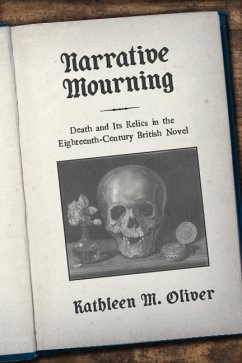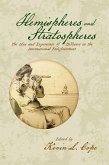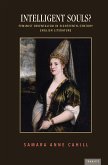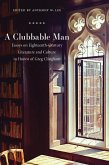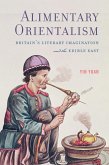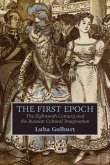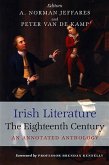- Broschiertes Buch
- Merkliste
- Auf die Merkliste
- Bewerten Bewerten
- Teilen
- Produkt teilen
- Produkterinnerung
- Produkterinnerung
Narrative Mourning argues that the cultural disappearance of the dead/dying body in eighteenth-century Britain found expression in fictional representations of the relic (object) or relict (person) within certain British novels. These relics/relicts exist as material signs of loss and as compensation for loss; they exist as surrogates for the absent (living, dead, or dying) and as reliquaries for their “psychic” essences.
Andere Kunden interessierten sich auch für
![Hemispheres and Stratospheres Hemispheres and Stratospheres]() Hemispheres and Stratospheres49,99 €
Hemispheres and Stratospheres49,99 €![Intelligent Souls? Intelligent Souls?]() Samara Anne CahillIntelligent Souls?40,99 €
Samara Anne CahillIntelligent Souls?40,99 €![A Clubbable Man A Clubbable Man]() A Clubbable Man45,99 €
A Clubbable Man45,99 €![Shelley's Style Shelley's Style]() William KeachShelley's Style61,99 €
William KeachShelley's Style61,99 €![Alimentary Orientalism Alimentary Orientalism]() Yin YuanAlimentary Orientalism40,99 €
Yin YuanAlimentary Orientalism40,99 €![The First Epoch The First Epoch]() Luba GolburtThe First Epoch30,99 €
Luba GolburtThe First Epoch30,99 €![Irish Literature the Eighteenth Century Irish Literature the Eighteenth Century]() Irish Literature the Eighteenth Century30,99 €
Irish Literature the Eighteenth Century30,99 €-
Narrative Mourning argues that the cultural disappearance of the dead/dying body in eighteenth-century Britain found expression in fictional representations of the relic (object) or relict (person) within certain British novels. These relics/relicts exist as material signs of loss and as compensation for loss; they exist as surrogates for the absent (living, dead, or dying) and as reliquaries for their “psychic” essences.
Produktdetails
- Produktdetails
- Verlag: Bucknell University Press
- Seitenzahl: 220
- Erscheinungstermin: 17. Juli 2020
- Englisch
- Abmessung: 234mm x 155mm x 15mm
- Gewicht: 340g
- ISBN-13: 9781684481910
- ISBN-10: 1684481910
- Artikelnr.: 58021911
- Herstellerkennzeichnung
- Libri GmbH
- Europaallee 1
- 36244 Bad Hersfeld
- gpsr@libri.de
- Verlag: Bucknell University Press
- Seitenzahl: 220
- Erscheinungstermin: 17. Juli 2020
- Englisch
- Abmessung: 234mm x 155mm x 15mm
- Gewicht: 340g
- ISBN-13: 9781684481910
- ISBN-10: 1684481910
- Artikelnr.: 58021911
- Herstellerkennzeichnung
- Libri GmbH
- Europaallee 1
- 36244 Bad Hersfeld
- gpsr@libri.de
KATHLEEN M. OLIVER is the author of Samuel Richardson, Dress, and Discourse , and her essays on Daniel Defoe, Sarah Fielding, Samuel Richardson, Frances Sheridan, Charlotte Smith, and William Wycherley have appeared in peer-reviewed journals and scholarly collections. In 2002, she received the Emilie du Châtelet Award for Independent Scholarship, bestowed by the Women’s Caucus of the American Society for Eighteenth-Century Studies.
List of
Illustrations
Introduction: The Relic
Objects
1 “With My Hair in Crystal”: Commemorative Hair Jewelry and the
Entombed
Saint in Samuel Richardson’s Clarissa (1748)
2 “You Know Me Then”: The Relic versus the Real in Ann Radcliffe’s
Mysteries of
Udolpho (1794)
Part I. The Secret Life of Portraits
Part II. Death as the Lost Beloved
Persons
3 “All the Horrors of Friendship”: Counting the Bodies in Sarah
Fielding’s David
Simple (1744) and Volume the Last (1753)
Part I. The Sorrows of Young David: Melancholia
Part II. Double Vision: Allegory
4 “It is All for You!”: Dying for Love in Samuel Richardson’s The
History of Sir
Charles Grandison (1753)
Ghosts
5 “‘Tis at Least a Memorial for Those Who Survive”: The
It-Narrator, Death
Writing, and the Ghostwriter in Henry Mackenzie’s The Man of Feeling
(1771)
Conclusion: Death and the
Novel
Acknowledgments
Works
Cited
Index
Illustrations
Introduction: The Relic
Objects
1 “With My Hair in Crystal”: Commemorative Hair Jewelry and the
Entombed
Saint in Samuel Richardson’s Clarissa (1748)
2 “You Know Me Then”: The Relic versus the Real in Ann Radcliffe’s
Mysteries of
Udolpho (1794)
Part I. The Secret Life of Portraits
Part II. Death as the Lost Beloved
Persons
3 “All the Horrors of Friendship”: Counting the Bodies in Sarah
Fielding’s David
Simple (1744) and Volume the Last (1753)
Part I. The Sorrows of Young David: Melancholia
Part II. Double Vision: Allegory
4 “It is All for You!”: Dying for Love in Samuel Richardson’s The
History of Sir
Charles Grandison (1753)
Ghosts
5 “‘Tis at Least a Memorial for Those Who Survive”: The
It-Narrator, Death
Writing, and the Ghostwriter in Henry Mackenzie’s The Man of Feeling
(1771)
Conclusion: Death and the
Novel
Acknowledgments
Works
Cited
Index
List of
Illustrations
Introduction: The Relic
Objects
1 “With My Hair in Crystal”: Commemorative Hair Jewelry and the
Entombed
Saint in Samuel Richardson’s Clarissa (1748)
2 “You Know Me Then”: The Relic versus the Real in Ann Radcliffe’s
Mysteries of
Udolpho (1794)
Part I. The Secret Life of Portraits
Part II. Death as the Lost Beloved
Persons
3 “All the Horrors of Friendship”: Counting the Bodies in Sarah
Fielding’s David
Simple (1744) and Volume the Last (1753)
Part I. The Sorrows of Young David: Melancholia
Part II. Double Vision: Allegory
4 “It is All for You!”: Dying for Love in Samuel Richardson’s The
History of Sir
Charles Grandison (1753)
Ghosts
5 “‘Tis at Least a Memorial for Those Who Survive”: The
It-Narrator, Death
Writing, and the Ghostwriter in Henry Mackenzie’s The Man of Feeling
(1771)
Conclusion: Death and the
Novel
Acknowledgments
Works
Cited
Index
Illustrations
Introduction: The Relic
Objects
1 “With My Hair in Crystal”: Commemorative Hair Jewelry and the
Entombed
Saint in Samuel Richardson’s Clarissa (1748)
2 “You Know Me Then”: The Relic versus the Real in Ann Radcliffe’s
Mysteries of
Udolpho (1794)
Part I. The Secret Life of Portraits
Part II. Death as the Lost Beloved
Persons
3 “All the Horrors of Friendship”: Counting the Bodies in Sarah
Fielding’s David
Simple (1744) and Volume the Last (1753)
Part I. The Sorrows of Young David: Melancholia
Part II. Double Vision: Allegory
4 “It is All for You!”: Dying for Love in Samuel Richardson’s The
History of Sir
Charles Grandison (1753)
Ghosts
5 “‘Tis at Least a Memorial for Those Who Survive”: The
It-Narrator, Death
Writing, and the Ghostwriter in Henry Mackenzie’s The Man of Feeling
(1771)
Conclusion: Death and the
Novel
Acknowledgments
Works
Cited
Index

